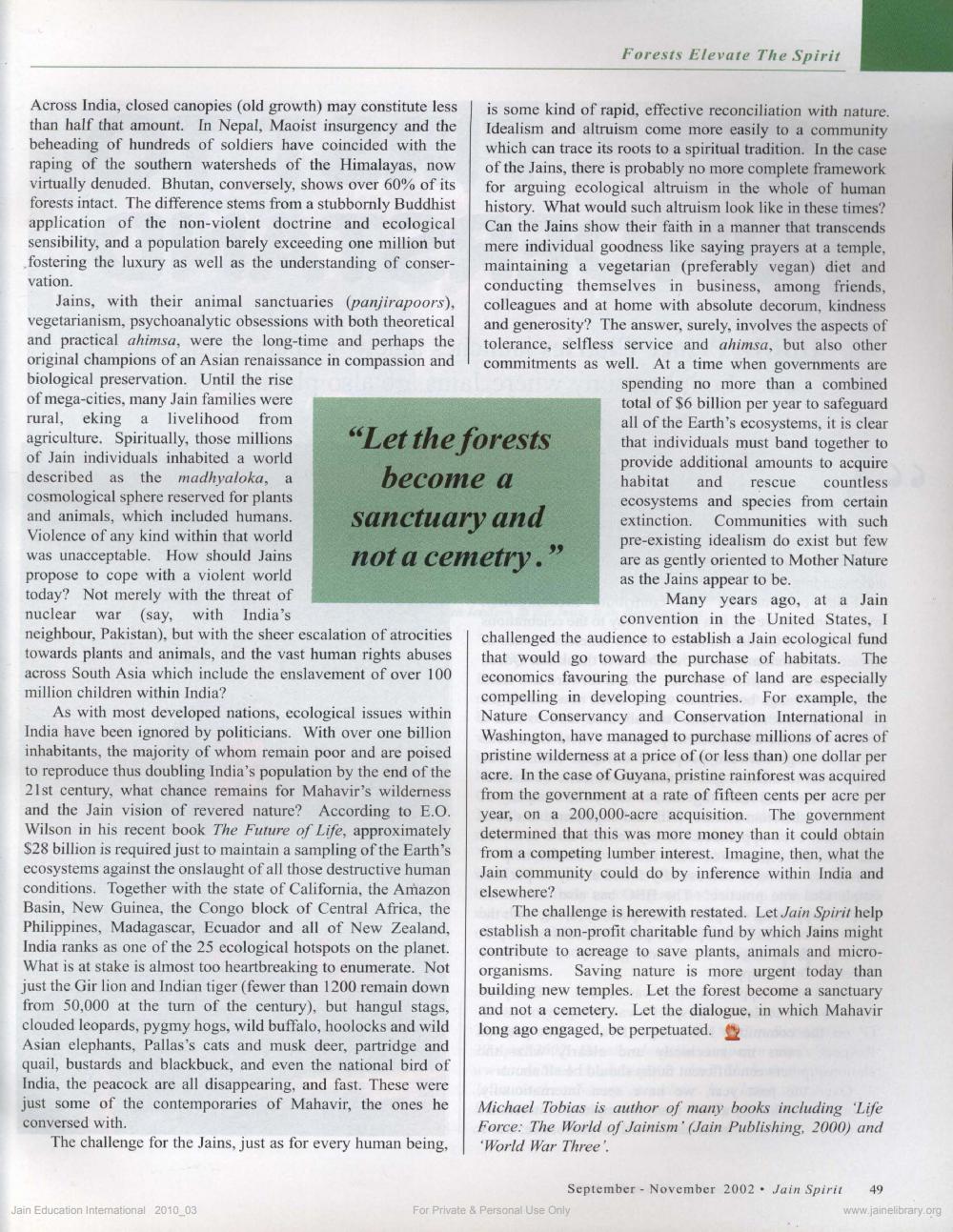________________
Across India, closed canopies (old growth) may constitute less than half that amount. In Nepal, Maoist insurgency and the beheading of hundreds of soldiers have coincided with the raping of the southern watersheds of the Himalayas, now virtually denuded. Bhutan, conversely, shows over 60% of its forests intact. The difference stems from a stubbornly Buddhist application of the non-violent doctrine and ecological sensibility, and a population barely exceeding one million but fostering the luxury as well as the understanding of conservation.
Jains, with their animal sanctuaries (panjirapoors), vegetarianism, psychoanalytic obsessions with both theoretical and practical ahimsa, were the long-time and perhaps the original champions of an Asian renaissance in compassion and biological preservation. Until the rise of mega-cities, many Jain families were rural, eking a livelihood from agriculture. Spiritually, those millions of Jain individuals inhabited a world described as the madhyaloka, a cosmological sphere reserved for plants and animals, which included humans. Violence of any kind within that world was unacceptable. How should Jains propose to cope with a violent world today? Not merely with the threat of nuclear war (say, with India's
neighbour, Pakistan), but with the sheer escalation of atrocities towards plants and animals, and the vast human rights abuses across South Asia which include the enslavement of over 100 million children within India?
"Let the forests become a sanctuary and not a cemetry."
As with most developed nations, ecological issues within India have been ignored by politicians. With over one billion inhabitants, the majority of whom remain poor and are poised to reproduce thus doubling India's population by the end of the 21st century, what chance remains for Mahavir's wilderness and the Jain vision of revered nature? According to E.O. Wilson in his recent book The Future of Life, approximately $28 billion is required just to maintain a sampling of the Earth's ecosystems against the onslaught of all those destructive human conditions. Together with the state of California, the Amazon Basin, New Guinea, the Congo block of Central Africa, the Philippines, Madagascar, Ecuador and all of New Zealand, India ranks as one of the 25 ecological hotspots on the planet. What is at stake is almost too heartbreaking to enumerate. Not just the Gir lion and Indian tiger (fewer than 1200 remain down from 50,000 at the turn of the century), but hangul stags, clouded leopards, pygmy hogs, wild buffalo, hoolocks and wild Asian elephants, Pallas's cats and musk deer, partridge and quail, bustards and blackbuck, and even the national bird of India, the peacock are all disappearing, and fast. These were just some of the contemporaries of Mahavir, the ones he conversed with.
The challenge for the Jains, just as for every human being,
Jain Education International 2010_03
is some kind of rapid, effective reconciliation with nature. Idealism and altruism come more easily to a community which can trace its roots to a spiritual tradition. In the case of the Jains, there is probably no more complete framework for arguing ecological altruism in the whole of human history. What would such altruism look like in these times? Can the Jains show their faith in a manner that transcends mere individual goodness like saying prayers at a temple, maintaining a vegetarian (preferably vegan) diet and conducting themselves in business, among friends, colleagues and at home with absolute decorum, kindness and generosity? The answer, surely, involves the aspects of tolerance, selfless service and ahimsa, but also other commitments as well. At a time when governments are spending no more than a combined total of $6 billion per year to safeguard all of the Earth's ecosystems, it is clear that individuals must band together to provide additional amounts to acquire habitat and rescue countless ecosystems and species from certain extinction. Communities with such pre-existing idealism do exist but few are as gently oriented to Mother Nature as the Jains appear to be.
Forests Elevate The Spirit
Many years ago, at a Jain convention in the United States, I
challenged the audience to establish a Jain ecological fund that would go toward the purchase of habitats. The economics favouring the purchase of land are especially compelling in developing countries. For example, the Nature Conservancy and Conservation International in Washington, have managed to purchase millions of acres of pristine wilderness at a price of (or less than) one dollar per acre. In the case of Guyana, pristine rainforest was acquired from the government at a rate of fifteen cents per acre per year, on a 200,000-acre acquisition. The government determined that this was more money than it could obtain from a competing lumber interest. Imagine, then, what the Jain community could do by inference within India and elsewhere?
The challenge is herewith restated. Let Jain Spirit help establish a non-profit charitable fund by which Jains might contribute to acreage to save plants, animals and microorganisms. Saving nature is more urgent today than building new temples. Let the forest become a sanctuary and not a cemetery. Let the dialogue, in which Mahavir long ago engaged, be perpetuated.
Michael Tobias is author of many books including Life Force: The World of Jainism' (Jain Publishing, 2000) and 'World War Three'.
September November 2002 Jain Spirit 49
For Private & Personal Use Only
www.jainelibrary.org




